There is no doubt that the best container size for tomatoes is, the larger the better!
Larger containers provide plants with greater area for roots and more soil means more moisture and nutrients.
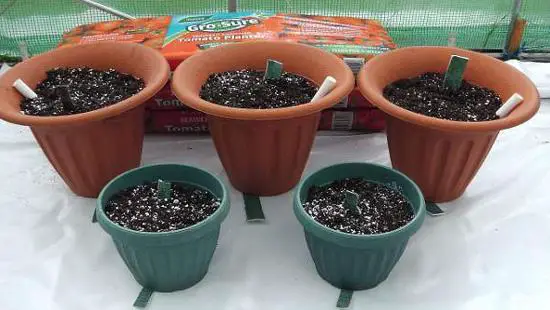
So how is it that professional growers can grow tomatoes in relatively small amounts of rockwool or coco-coir, and get great results?
The answer is – they grow tomatoes by using some form of reservoir or watering system. By having a steady supply of water and nutrients available, is doesn’t really matter what the best container size for tomatoes is – within reason of course.
Highly recommended are the Quadgrow, Oasesbox and Autopot systems.
Watering smaller containers
Another way to water, so that plants have access to a regular water supply, is the use of a tap timer and piping. Not only will it water your plants twice a day, it is perfect for hanging baskets and smaller containers that dry out quickly on a hot day – also ideal for holiday watering too!
You’ll need an outside tap and the time and patience to measure the lengths and fix it together – it can be a bit fiddly!
Best container size for tomatoes in final position planting
Choosing the size of container to use, for planting tomatoes in their final position, depends on a number of things – mainly how the plants will be watered but also, plant size, fruit size, media used, leaf size, early or late to mature etc.
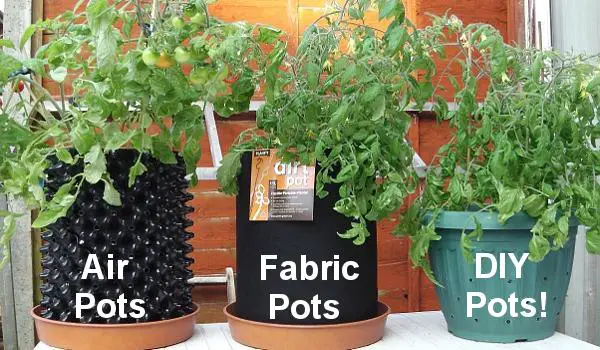
For example, a dwarf variety can grow in a 6 inch pot but most beefsteak varieties will need a much larger area for their roots.
A variety with a large leaf area will require a bigger pot (in theory) because it will lose more moisture through its leaves and therefore require a larger soil area from which to obtain water.
Also, a variety that matures early may need less growing room because its season is shorter than a late maturing variety for example, so it needs less resources.
As valid, and long winded, as these points may be, they don’t get to the heart of the matter.
Better growing methods mean you can use smaller pots
The fact is, the better the growing methods used (i.e. growing media, type of container and access to water and nutrients), the smaller the container size that is required for a successful crop.
The plant below is Sweet Aperitif growing in an 8.5 litre pot using the Auto Pot system. It was trained to three stems.
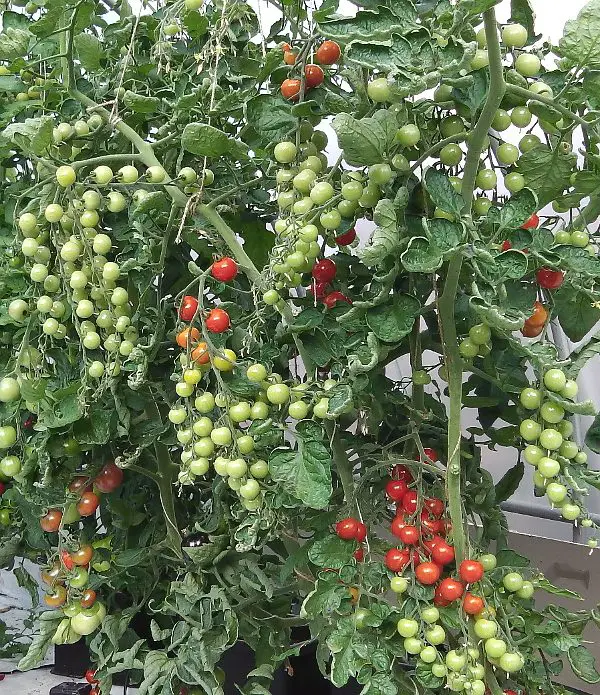
Allowing the main stem and two side shoots to grow (making three stems), is only recommended with cherry varieties in a short season area like the UK.
Traditionally, especially in the USA, a pot that holds 5 to 10 gallons (US) of soil is considered suitable for a tomato plant. That’s around 20 to 40 litres – but the Oasesbox and Autopot use around 8 litres and the Quadgrow around 11 litres.
How can we get such good results from much smaller containers?
A tomato grower who uses basic potting compost, a traditional pot and waters whenever the soil seems dry, will need a bigger pot to achieve good results than someone who gives their plants exactly what they need – when they need it. The extra soil in a larger pot acts as a buffer zone or safety net!
Using large pots with lots of soil is a bit like using a golf club with a head twice the size as normal – you’ve got more chance of hitting the ball!
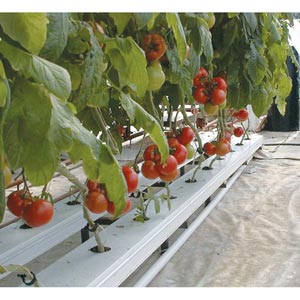
With best growing practices, it’s possible to use a 10 litre rather than a 15 litre pot. It’s possible to grow most varieties successfully in an 8 litre pot too. It’s how we grow them that determines the pot size.
But what about the roots?
When using basic equipment, it is true that tomato plant roots need plenty of room.
However, by watering and feeding so that plants can take what they want, when they want, means that they won’t grow big root systems because they don’t need to!
Just to take the point to the extreme, a lot of supermarket tomatoes (the best quality ones) are now grown using the Nutrient Film Techniques (NFT).
This method doesn’t require any growing medium at all – roots are suspended in a trough of flowing water and nutrients, a bit like a horizontal drain pipe. Water and nutrients flow over the roots several times each day (or hour!) and plants are able to access all they need.
This includes:
- Water
- Nutrients
- Oxygen
Containers vs Garden Border Soil
The above applies to container growing. If planting directly into the garden soil, or growing on an allotment, the bigger the root system, the better. Plants are left to “get on with it” so a root system that cover a bigger area is going to be able to find more water and nutrients.
Creating the best growing conditions
- Tomato plants need a good medium that contains lots of oxygen and doesn’t dry out too quickly to avoid water stress.
- They need access to water and nutrients 24/7 – when the plants want them, rather than when we give them.
- Also, they need good aeration in a greenhouse, pollytunnel or on the windowsill producing good transpiration and avoiding disease.
- Lastly, they need plenty of light to maximize photosynthesis.
Getting more air into container soil
Rot capping is when surface roots become so pot-bound that they form a cap of tight fibrous roots at the soil surface. Oxygen is prevented from entering into the root area below and the gasses that are given off by respiration are prevented from escaping.
It is particularly important for those feeding organically that there is plenty of oxygen in the root system because soil microbes need oxygen too!
It’s possible to use air pots and smart pots, lots of perlite and even drill holes in the side of standard pots and containers. Another option that has been around for some time, although not often mentioned, is the air pipe or air tube.
The Air Pipe
This is a pipe that goes into the soil with holes in the side. It allows more oxygen into the root area and gasses can get out. Particularly important when using tall pots and larger containers.

I used to use the air pipe for all of my containers, but I found that it is most beneficial with large containers of 15 litres and above.
Of course if roots have access to oxygen through the sides of a container – air pot, fabric pot etc. they won’t need the air pipe.
The importance of oxygen in the root zone
- It helps encourage friendly bacteria that converts organic material into plant food.
- Helps prevent anaerobic bacteria that causes root disease.
- Increases the rate of respiration – gives plants energy.
For more information about respiration click here.
Another lovely sunny day here in the UK … hope the weather is good where you are!
Regards,
Nick

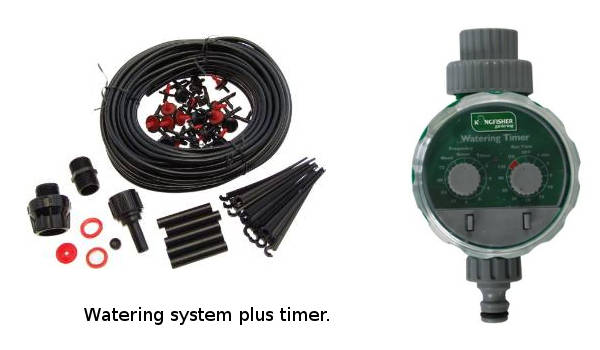
Jess Allaway
Hi Nick,
I thank you for the newsletters which i am enjoying as usual. I am wondering if you can advise me regarding shading.
We have had this very hot weather for the past week and I have had great trouble getting the temperature in GH below 30C. I have shading over the top and a couple of feet down each side. I throw water on the slab floor which brings it down only a couple of degrees and the double doors, all windows and louvre vents are fully open. I know tom’s don’t need direct sun for ripening the fruit, but how does shading affect plants at the flowering stage? Do they really need direct sun at that point? Also if anyone else has ideas for cooling I would be interested to hear. My cousin who lives in Australia says they hang up wet towels on their veranda to bring cool air into the house. Might have to put a washing line in GH!
Best regards
Jess.
Robert Smith
Hi again Nick, you very kindly advised me recently when to start using the air pump and stones in my quadgrow troughs, I should also have asked you at the time “how long should I run the pump, continuously or intermittently” ?
many thanks again
Robert
Rhys Jaggar
Nick
May has been unbelievable for tomatoes here: perfect temps, plenty of sun, not too cold at night. Not so good for things needing rain – onions needing lots of watering, ditto turnips, spinach, lettuce etc.
Four maincrop plants left for final pots on Monday, given weather forecast, soil based going in on Monday too and 31st for Quadgrows and other competition plants.
One thing about small pots is that if you grow tall plants the stability is not good unless they lean against something – I suspect string attached above and fixed into the soil is a better guide than sticks for small 6 inch pots if you want a 6ft plant…..
12 inch pots work fine for Black Russian beefsteaks (8-10lb per plant), Rhizopots work well for Super Marmande (8-12lb per plant), as they do for all bush plants (Maskotka etc).
I must say I have been very successful applying feed and water via saucers in which final pots (not breathable Rhizopots) stand: seaweed as a balanced food, various tomorite concentrations or comfrey tea as potassium-rich food. Rarely after June 1st will this cause root problems and pots can be removed from saucers if cool weather visits. Applying liquid morning and evening (lunchtime too if temp exceeds 27C) means plants are always receiving water and nutrients on a daily basis.
Last year with Quadgrows my yields were the best yet with 5lb of Zenith salad tomatoes from a plant with 4 trusses. They also developed very rapidly, saying Quadgrow is great if length of season is a concern.
Nick
Hi Rhys,
Some very useful information – as always!
Nick
Rob
Thank you Nick; I have used air pipes since you outlined them in your newsletter many years ago. I can vouch for their effectiveness in plastic and non-aerated pots.
And thank you Rhys for your advice to give seedlings a feed of Epsom’s Salts. It perked mine up noticeably.
Cheers!
Rob
Nick
Hi Rob,
It’s good to know that you found the air pipes effective!
Cheers,
Nick